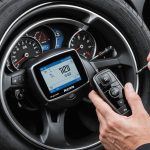Ultimate Guide: Must-Check Components of Your Vehicle’s Emergency Braking System Before You Hit the Road
When it comes to ensuring your safety on the road, the emergency braking system of your vehicle is one of the most critical components to focus on. Whether you’re driving a car, truck, or any other type of vehicle, understanding and maintaining your braking system is essential. Here’s a comprehensive guide to help you check and maintain the key components of your vehicle’s emergency braking system.
Understanding Your Braking System
Before we dive into the specifics of what to check, it’s important to understand how your braking system works. The braking system is designed to slow or stop your vehicle safely, and it involves several key components.
Also read : Vital strategies to enhance hydraulic brake efficiency in vehicles navigating hilly terrain
The Role of ABS in Your Braking System
The Anti-lock Braking System (ABS) is a crucial part of modern vehicles. It allows the driver to maintain directional control during braking by preventing the wheels from locking up and skidding. ABS works by tracking wheel speed and modulating the brakes to ensure maximum braking effect without losing control[1].
“ABS is on the vehicle to prevent accidents. It does this by allowing the driver to maintain directional control during braking,” explains a safety expert. To ensure ABS is functioning correctly, you need to know how to inspect it properly.
Additional reading : Ultimate checklist for ensuring your off-road vehicle”s rear differential lock works effectively
Inspecting Your ABS
Inspecting your ABS involves several steps:
Key Components to Check
- Wheel Sensors: These sensors track the speed of each wheel and send signals to the control unit.
- Control Unit: This is the brain of the ABS system, processing the data from the wheel sensors and controlling the modulating brake valves.
- Modulating Brake Valves: These valves apply and release brake pressure to prevent wheel lock-up.
- Connecting Wiring: Ensure all wiring is intact and not damaged.
The Key-On ABS Check
This is a critical part of your pre-trip inspection. Here’s how to do it:
- Turn the key on when the vehicle’s air system is at normal operating pressure.
- Verify that all three malfunction lights (tractor ABS, trailer ABS, and the trailer-mounted light) come on. This indicates the lamps are working and a self-test is underway.
- Once the systems pass the self-test, the malfunction lights will go out. If any light remains on, there is a malfunction that needs to be repaired[1].
Brake Fluid: The Lifeblood of Your Braking System
Brake fluid is a safety-critical component that transmits pressure from the brake pedal to the brake calipers. Here’s what you need to know:
Types of Brake Fluid
Different types of brake fluid have different specifications and uses:
| Type | Description | Suitable For |
|---|---|---|
| DOT 3 | Lower boiling point, more susceptible to steam bubble formation | Older vehicles without modern brake control systems like ABS or ESC |
| DOT 4 | Higher dry and wet boiling points, suitable for ABS and clutch systems | Most modern vehicles with disk and drum brake systems |
| DOT 5.1 | High thermal stability, ideal for modern brake control systems like ABS and ESC | Modern vehicles with advanced brake systems, including electric vehicles |
“Brake fluids must withstand extreme conditions, including high temperatures and pressures,” notes a brake fluid expert. “It’s crucial to follow the manufacturer’s specifications strictly”[2].
Checking and Changing Brake Fluid
- Regular Checks: Brake fluid attracts water over time, which can lead to reduced braking performance. Check the brake fluid regularly for signs of contamination or degradation.
- Changing Interval: As a rule of thumb, brake fluid should be changed every two years or as specified by the vehicle manufacturer.
- Signs of Contamination: If the brake fluid contains water, it can cause a spongy feeling when braking. Check for this and replace the fluid if necessary[2].
Air Brake Systems: Special Considerations
For vehicles equipped with air brake systems, there are additional checks to perform:
Maintaining Proper Air Pressure
- Ensure the air pressure remains within the manufacturer’s specifications, typically between 100–120 PSI.
- Test air pressure gauges daily and monitor for leaks using a pressure drop test[5].
Inspecting Air Hoses and Slack Adjusters
- Check air hoses for cracks or leaks.
- Ensure proper slack adjuster clearance to prevent brake failure[5].
Warning Lights: Your Car’s Way of Telling You Something is Wrong
Dashboard warning lights are more than just colorful distractions; they are critical tools for keeping you informed about your car’s health.
Common Warning Lights Related to Braking
| Icon | Meaning | Action |
|---|---|---|
| 🟧 ABS Malfunction | ABS system malfunction | Have the ABS system inspected and repaired as soon as possible |
| 🟧 Brake Warning | General brake system malfunction | Check the brake system, including brake pads, shoes, and fluid |
| 🟧 Traction Control | Traction control system engaged or malfunction | Monitor driving conditions; inspect the system if the light remains on |
| 🟩 Parking Brake | Parking brake is engaged | Release the parking brake before driving |
“Understanding what these lights mean can help you act quickly and avoid costly repairs,” advises a car maintenance expert. “If in doubt, always consult your car’s owner manual or seek assistance from a professional”[4].
Practical Tips for Maintaining Your Braking System
Here are some practical tips to ensure your braking system remains in top condition:
Perform Routine Inspections
- Pre-Trip and Post-Trip Inspections: Include checks on brake pads or shoes for thickness, air hoses for cracks or leaks, and proper slack adjuster clearance.
- Check Brake Pads and Shoes: Replace them before they reach their minimum thickness (typically 4/32 inches for commercial trucks) to avoid damage to the rotors or drums[5].
Test Your Brakes Regularly
- Emergency Braking Test: Occasionally test your emergency braking to ensure it is functioning correctly.
- Brake Pedal Feel: Check for any spongy feel when pressing the brake pedal, which could indicate contaminated brake fluid[2].
Maintaining your vehicle’s emergency braking system is not just about safety; it’s about ensuring you and your passengers arrive at your destination without any incidents. Here are the key takeaways:
- Understand Your ABS: Know how to inspect and test your ABS system.
- Check Your Brake Fluid: Regularly inspect and change your brake fluid as needed.
- Monitor Air Brake Systems: Ensure proper air pressure and inspect air hoses and slack adjusters.
- Pay Attention to Warning Lights: Understand what each warning light means and take appropriate action.
- Perform Routine Inspections: Regularly check your brake pads, shoes, and other components.
By following these guidelines, you can significantly enhance the safety and reliability of your vehicle’s braking system. Remember, your car’s braking system is its most critical safety feature, and maintaining it is your top priority.
Additional Resources
For further information and detailed guides, here are some resources you might find helpful:
- FMCSA Guidelines: For commercial vehicles, the Federal Motor Carrier Safety Administration provides detailed guidelines on brake system inspections and maintenance[1].
- Vehicle Manufacturer Manuals: Always refer to your vehicle’s owner manual for specific instructions on brake system maintenance and inspections.
- Professional Mechanics: If you’re unsure about any aspect of your braking system, consulting a professional mechanic can provide peace of mind and ensure your vehicle is safe to drive.









